Sam’s Note: This review was written by my Dad. He is a lover of history and taught me to love it as well. Many a family vacation was spent at historic sites, museums and battlefields. I remember standing near the Bloody Angle at Spottsylvania with my dad on my 14th birthday. It was August in the south but it was quiet, and spooky. Henry Rifles were used there in 1864.
[full_width]
[/full_width]
Buy one on GunsAmerica: https://www.gunsamerica.com/Search.aspx?T=henry%20original
Check out the Henry: https://www.henryrifles.com/rifles/the-henry-original/
From Guest Contributor Harold Trisler
Hell yes , we love the old west. Lots of us old coots go to great lengths to just experience a mere taste of it. Friends, I hope someday you get a request from the editor of Guns America to review a Henry. Really a Henry, and an American made Henry to boot. Where do I sign up? I first met the editor, some years ago , when he had one of the worst chores of any western era, wrangling donkeys through the mountains of New Mexico. It’s that kind of experience that makes an editor well rounded, and he wants me to review a Henry rifle.
The Allure of a Henry
It’s hard to overestimate the mystique of a Henry. I think it has something to do with it being stuck in a period of time, it did not evolve, like the Colt or the Winchester. Yes, it did evolve into the Winchester but the Henry stayed THE HENRY. It represents it’s place in history the same way a flintlock does. And there were only about 14,000 of the originals made by the New Haven Arms Company, which makes originals rare and valuable today.
When my son and I visited one of the great old gun stores in New Orleans, James H. Cohen and Sons, the owner told us his grandmother’s advice was to always try and keep a Henry in the shop–a testament to the unique appeal of this gun. She meant that having a Henry in stock gave their shop more respect and prestige. There are not that many original Henry’s floating around the market at any given time and they command a high price.
The gun was first produced in 1860, just in time for The War Between the States. It was carried by several different Union units. It was the most successful repeating rifles of its time. The only other repeater made in any quantity was the Spencer. The Spencer is a good rifle in a lot of ways, but the Henry had it beat. The Henry held more rounds, self-cocked its hammer when the action was worked, and was faster and easier to reload.
It is a tribute to the value of the Henry that troops would take it into battle despite an uncertain war time supply of rim fire cartridges. By the end of the war, the Federals had addressed the need for ammo by buying over four million rounds of .44 Henry Rimfire. Speaking of government buying–the US Army and Navy only purchased about 1,700 Henry Rifles during the war. The others were bought by the soldiers themselves and the Army was happy to keep the Henry’s fed.
Other than its cool looks, because it is a really cool looking rifle, part of the allure of the Henry is its historical significance. The Henry evolved out of the Volcanic Arms guns that used a hollow based bullet that contained a powder charge, there was no case like me know today. This caseless ammo was very weak and prone to moisture issues. The Volcanic loaded like the Henry with the lever, but the Henry fixed the ammunition problem using a copper (later brass) cartridge. The advent of the metallic cartridge, and the first guns that usefully utilized them, was a game changer. The average solider during the Civil War could load and fire 3 rounds in 1 minute with the standard infantry musket. The Henry and other rifles using the metallic cartridges could fire 3 rounds in seconds. The Henry evolved out of the Volcanic and the Winchester evolved out of the Henry. Three pretty significant guns right there.
Specs
Below are the specs on the new Henry rifle being made by the Henry Repeating Arms Company. This is the review rifle and we will get into the differences with the original Henry in a bit.
- Action Type Lever Action
- Caliber .44-40
- Capacity 13 + 1
- Length 43″
- Barrel Length 24″
- Weight 9 lbs.
- Stock Fancy American Walnut Buttstock with Hardened Brass Buttplate
- Sights Folding Ladder Rear, Blade Front
- Finish Hardened Brass Receiver with Blued Steel Barrel
- M.S.R.P. $2,300.00
Other than the price (a Henry sold for about $30 in 1860), the only main difference is the chambering. The originals were made in .44 Henry Rimfire. Rimfire cartridges were the first type of brass cartridge to really be successful and somewhat reliable, but it didn’t take long to develop the more reliable center fire.
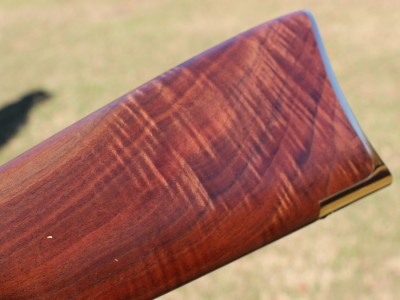
Beautiful grain on the American Walnut stock. This Henry is not just a reproduction, it is a beautiful done one.
Better than the real thing
The fit and finish on the new Henry is fantastic. It is really, really well done. The fit of the stock to the receiver is smooth and seamless. Speaking of the stock, this is one nice piece of American Walnut–so nice, that these far surpass the originals when it comes to looks. The receiver is polished to a high gloss and is so reflective it was hard to take pictures that didn’t show the camera. Bluing on the barrel is deep, dark and lustrous. It really has some of the best fit and finish I have seen on a new production gun. It reminds me of the attention to detail and polishing found on pre WWI Colts.
Another thing that makes this version of the Henry better than the originals is in the materials. Aside from the piece of Walnut used in the stock (originals didn’t have that nice of wood), the metal used for the barrel and the action parts is stronger and of better quality. There have been a lot of advances in metallurgy since 1860 and the new Henry takes advantage of this.
There are other Henry reproductions on the market. Uberti in Italy also makes a nice version. But they are not this nice–this one made by the Henry Repeating Arms Company is 1st class. It is also made in the USA which, as far as I know, has not happened since 1866.
The Henry Quirks
The Henry is not your typical lever action. When Winchester bought out The New Haven Arms Company, the makers of the original Henry Rifle, they made some improvements that became the 1866 Winchester. The biggest improvement was the loading gate on the side of the receiver that just about every lever action rifle made since has had. The new Henry still loads oddly and awkwardly.
Take a look at some of the pictures below for more details on the loading of a Henry. In short you pull a lever towards the muzzle to depress a spring and then you turn part of the barrel and magazine tube to the side to allow you to load the tube. Once everything is loaded and turned back into place, the Henry is ready to go. However, when firing the Henry you should remember that you are holding a historic fire arm. Once loaded, it must be shot as only a Henry requires. You have to be aware of that ever descending loading lever under the barrel and it will hit, and stop, on your hand if you are gripping forward of the receiver. When this happens there is no spring pressure on the rounds in the magazine and the Henry will not load correctly.
[full_width]
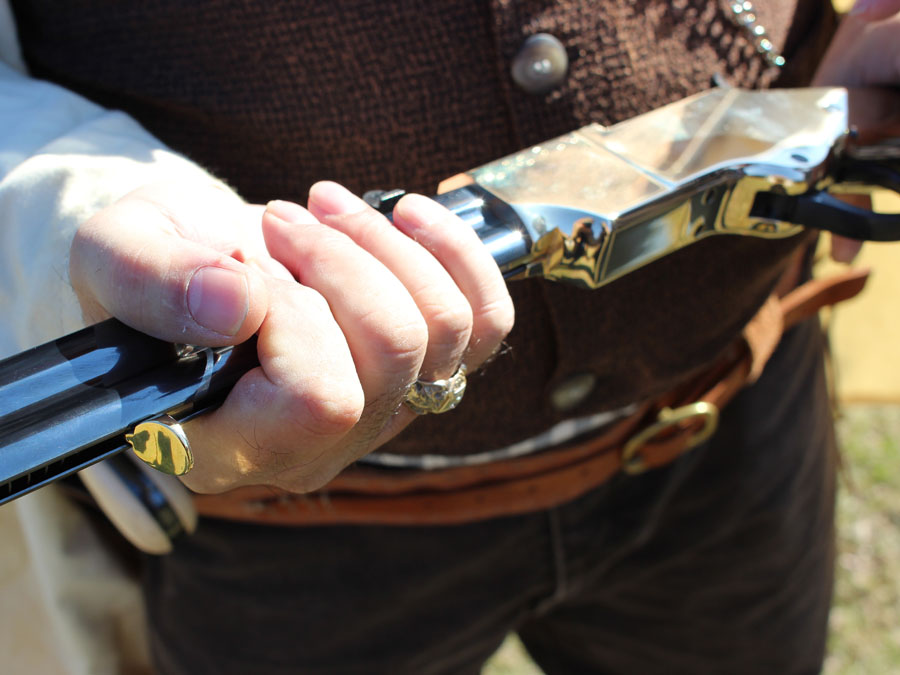
If you look closely at the support hand, you will see the loading spring’s brass tab. As it slides down the tube, you have to let it move by.
[/full_width]
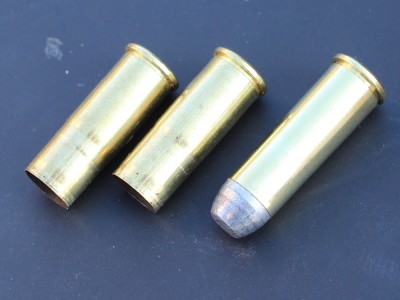
Look closely at the two fired cases. They do have a shoulder that is easy to see. The unfired Buffalo Bore does not.
Ammunition Issues
Before we get into the the shooting report of this review I need to take a few words to talk about an ammo issue we came across. I have noticed the same problem with other old Winchester Center Fire Cartridges. There must be a pretty wide range of acceptable chamber and cartridge sizes. The 44-40, or .44 W.F.C, is a bottle necked case. It is a very slight bottle neck with a gentle slope to its shoulder, but there is supposed to be one.
We had two different brands of ammo at the range while shooting the Henry. The Hornady had a pronounced shoulder and bottleneck while the Buffalo Bore did not. The Hornady functioned flawlessly. It loaded, cycled, fired and ejected without issue. The Buffalo Bore didn’t want to fit into the chamber and we had to use more force than normal to close the action. It felt like we were forming the case’s shoulder with the chamber as we hammered the gun into battery. Extraction of a fired round was smooth, but you don’t always fire every round. Cycling the action with a live Buffalo Bore in the chamber would (more times than not) result in the extractor tearing through the rim. Getting the live round out after that (remember, it didn’t fit all that well going in) is, as they say, awkward.
[full_width]
[/full_width]
The Buffalo Bore also didn’t have a sufficient crimp around the case mouth to hold the bullet in place. We noticed this when we didn’t load a full magazine and the brass plunger was dropped. It was not a one time thing, either as we were able to replicate it. When the plunger whacked the bullet, the bullet was pushed into the case. Luckily we noticed this and didn’t fire the cartridge as the drastic change in seating depth of the bullet, close to a half inch if not more, would change the pressure–big time. The new Henry is a very well made rifle using modern steel, but I am not sure how it would have held up firing over-pressure rounds.
Shooting
Other than the above ammo issues, the Henry functioned and shot flawlessly. How has the old girl held up in terms of shooting? Well , it still loads oddly-but not as much as the muzzle loaders it replaced.
And the quirks are exactly what bring home the fun of shooting a non-modern weapon. This new-old gal is also a tack driver at close ranges. We attempted to work it out a lot further and ring a steel plate at 200 yards, but we didn’t have much luck. Most of that I attribute to the light powder loads of the cowboy action rounds. We’re going to get our hands on some full-power cartridges soon and see what we can come up with.
[one_half]
[/one_half][one_half_last]
[/one_half_last]
In Conclusion
If you like history and historic firearms, owning a Henry is at the top of most peoples lists. It is also out of the reach of most shooters. Original Henry’s are rare and very expensive. There is also the rarity of the ammo they shoot–when is the last time you saw a box of .44 Henry Rimfire on the shelf? Not since the 1930s, probably. But the Henry Repeating Arms Company has made a real gem here. It is better made and made out of better materials than the originals and still gives you the function and feel of the original. That is one of the things that shooting old gun designs gives you, a feel for the past. It is certainly better than herding donkeys.
Buy one on GunsAmerica: https://www.gunsamerica.com/Search.aspx?T=henry%20original
Check out the Henry: https://www.henryrifles.com/rifles/the-henry-original/
[one_half]
[/one_half][one_half_last]
[/one_half_last]
[one_half]
[/one_half][one_half_last]
[/one_half_last]
[one_half]
[/one_half][one_half_last]
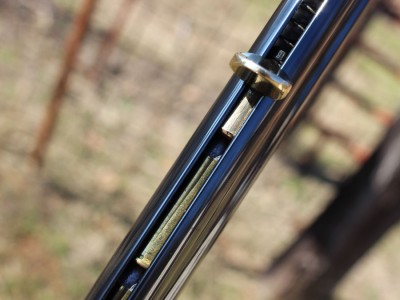
This tab will slides down the tube and keeps spring pressure on the rounds. If it hits your hand, the rounds don’t feed easily.
[/one_half_last]
[one_half]
[/one_half][one_half_last]
[/one_half_last]
[one_half]
[/one_half][one_half_last]
[/one_half_last]
[one_half]
[/one_half][one_half_last]
[/one_half_last]
[one_half]
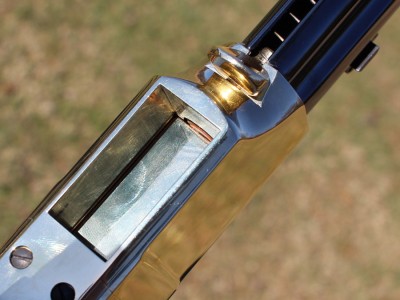
The lifter lifting, only from below. The brass tab is all the way down the mag tube, but there still may be a round in the receiver.
[/one_half][one_half_last]
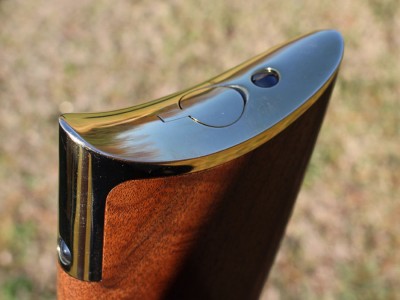
It is best to put the butt-plate on your boot when loading, if you want to keep it looking sharp–but angle the barrel away from your face–just in case.
[/one_half_last]
[one_half]
[/one_half][one_half_last]
[/one_half_last]
[one_half]
[/one_half][one_half_last]
[/one_half_last]
[full_width]
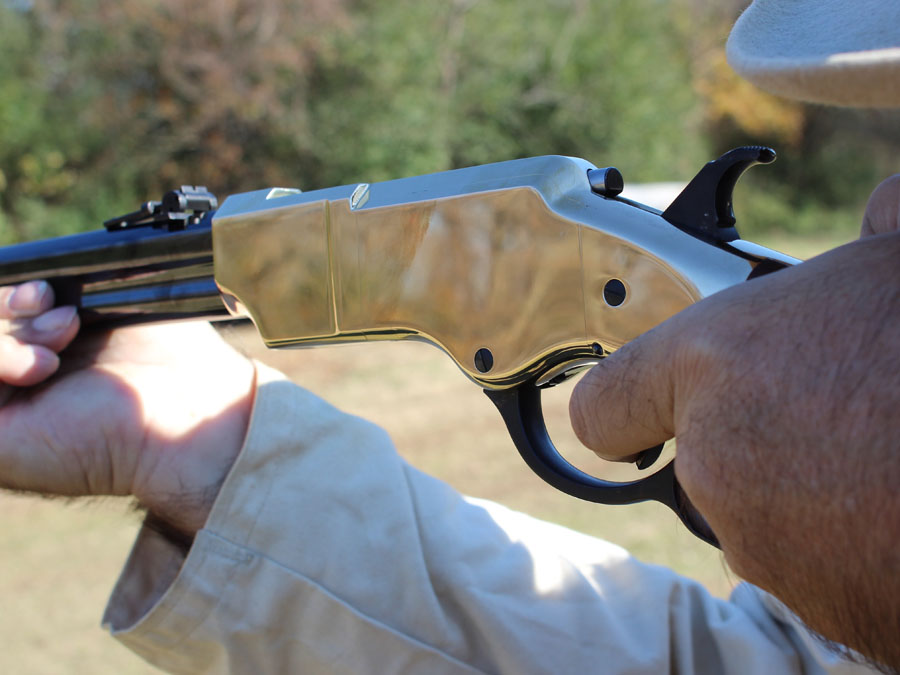
The real question for some collectors will concern wear-and-tear. The brass will scratch and tarnish. My opinion? Shooting the Henry makes legitimate wear worth it.
[/full_width]

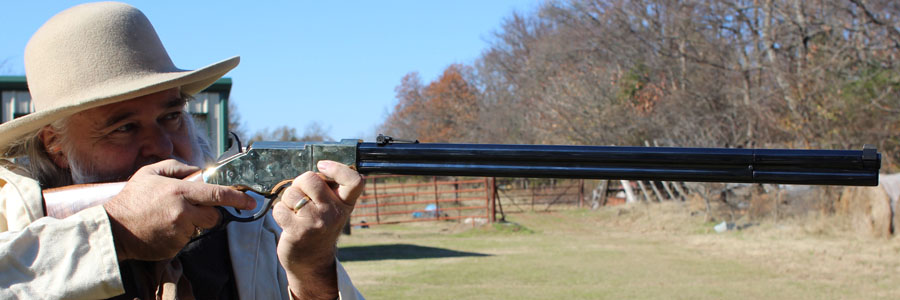
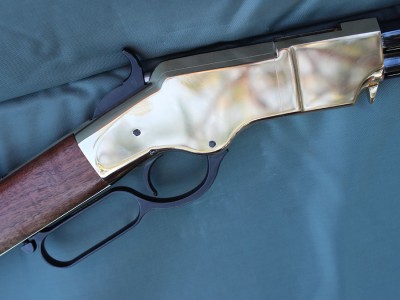
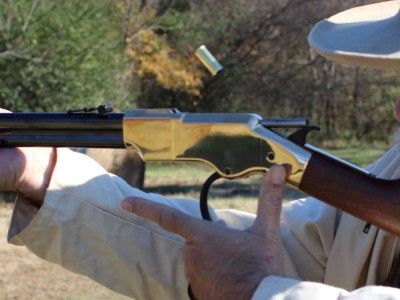
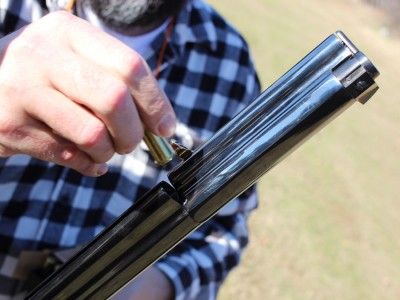
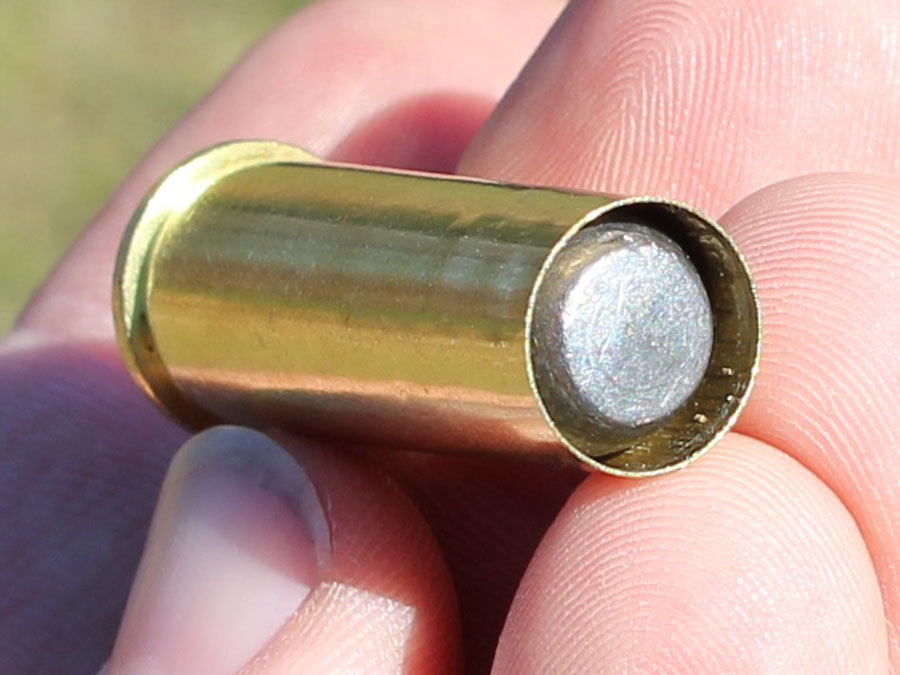
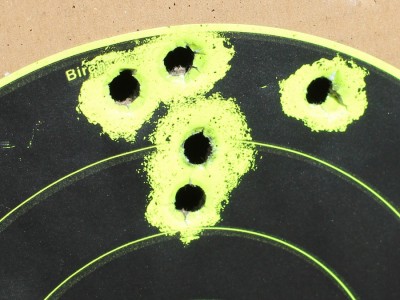
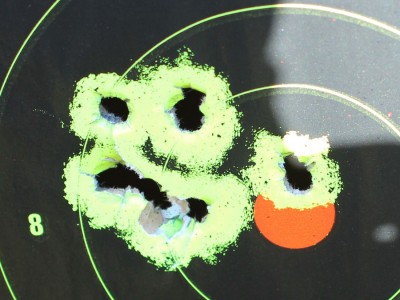
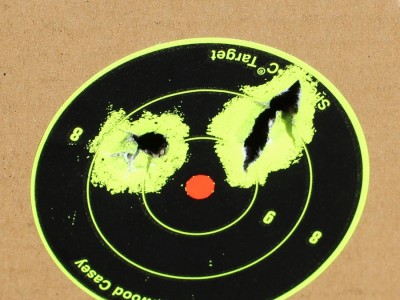
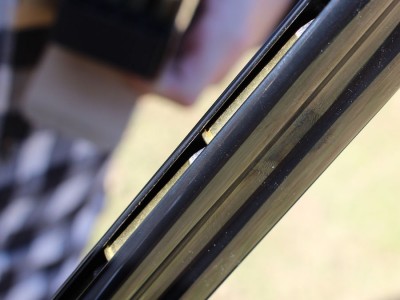
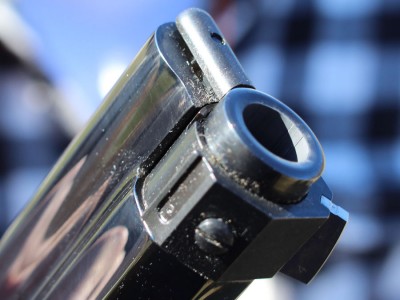
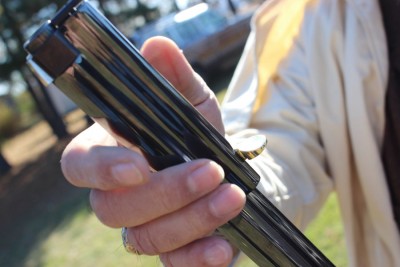
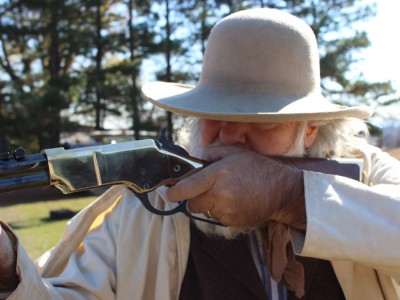
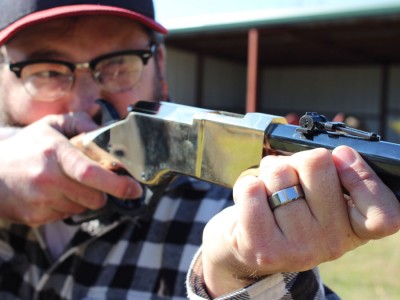
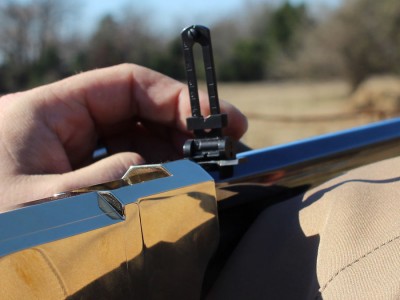
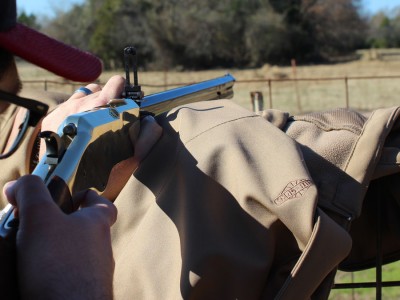
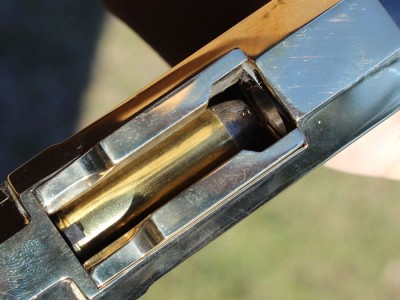
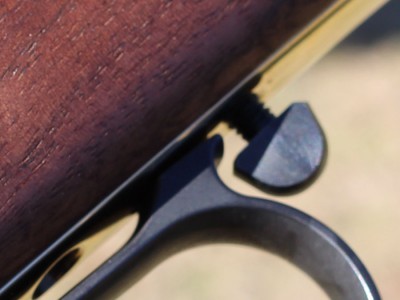
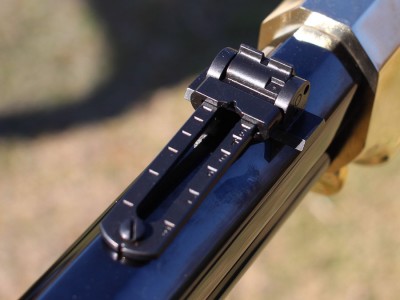
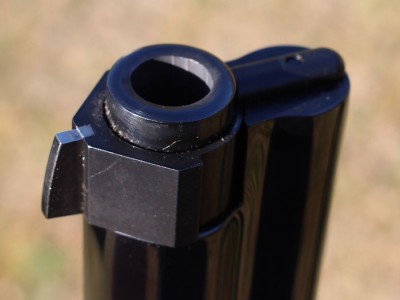
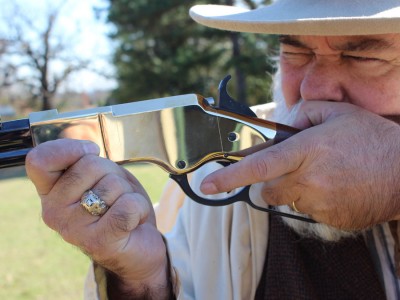
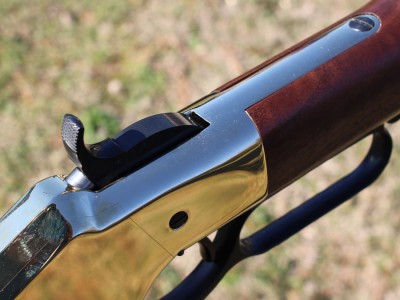
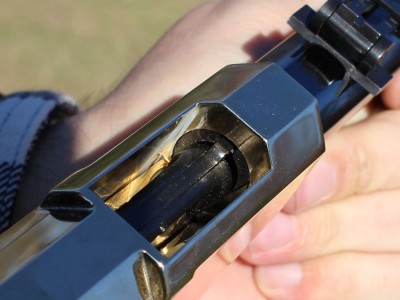
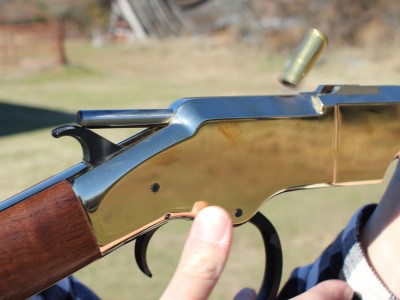
Henry’s customer service is really good! You can Email the CEO Anthony Imperato personally and he answers personally. I was having difficulty finding a dealer with a New Original Henry and Mr. Imperato had his Email in a video I watched on the company website and said if you were having issue you could contact him directly for help. I did so and he put me in touch with a distributor who could help me with my purchase.
The CEO of a major company…that’s good customer service!
What is the best use of the stock compartment that opens at the butt plate. Perhaps a screwdriver? It is too small for a cleaning kit rod.
This is the elephant in the room. No one replies because no one really knows. I think best is a screwdriver. Only four rounds of my .45 will fit with about a half inch to spare. A bore light could fit. A tiny flashlight could fit.
I have 7 different Henry Rifles. I gave each of my 3 Grandchildren a 22 Long Rifle Henry and they all can’t say enough good things about them. I just got the Henry 357/38 Rifle. With a nice Scope it’s great fun to hunt and target shoot with. I also have the Henry original 45 Rifle. It’s a blast to shoot. Take some time to study the user’s DVD. You will be glad you did. I ordered the original 44 rifle and can’t wait to get it. I’m quite sure it will be a nice weapon as well. It will handle deer, bears, and even moose.
I will be a Henry owner and advocate for as long as I live!
Everyone have a blessed day and enjoy the great outdoors,
Bill Moss
Funny thing is none of you that made comment in here are ever going to see any sort of return in resale on a new henery is gonna be difficult because they are junk and the resale of them is so damn cheap whoever buys one new should first review just how shitty these rifles are ! Resale on one of these mint is less than half of the purchase price and never has left the box!
You sound angry…. are you? Did you buy one and then try to sell it again? And why are they junk…just because you say so???
I don’t believe you have the right to claim that the metals used are of better quality since the metal is now cheep Chinese steel being used in the new henery guns .furthermore you needed to make this article an opinion not based on fact at all because none of what you have said is fact ! The older rifles are much more beautiful ! This is why they bring high dollars ! Because they do look better and are of better materials and are hand made each rifle ! You apperantly have no clue as to the process of manufacturing these new cheep knockoffs they are junk ! They are a pretty price of junk ! They don’t compare in any way at all and are made by an Italian company which is even more of a kick in the ass ! Henry stole that idea in Winchesters plant where he worked when he supposedly designed the repeater . get your facts correct! The materials are not of USA origin for the new pieces and they rust very very fast from just a touch with means junk Chinese metal ! Never buy a new henery as who wants to shoot pretty when you could shoot with dignity and style and acurracy with a real manufactured and forged USA rifle and rest knowing its real unlike the new fake crap you are trying to pedal to the consumer this junky ass henry overpriced rifles because in our stores we don’t carry knockoffs only originals
Ah… the wood on the new ones is MUCH better than on the originals. You do realize that don’t you? Also regardless of where made newer metal processes are better as is the steel composition///more uniform, better cutting/forming machinery.
Meant to say “regardless of where the metal is made, metal forming today is more precise and uses tighter tolerances on chemical composition, milling, cutting, etc.”
Whew. Bryan, it would be most useful if you would stop hem-hawing about and say what you REALLY think.
Was the first, original 1860 rifle made with the brass receiver or the steel receiver?
I think a lot of N/SSA shooters would dispute the Uberti being inferior. In fit and finish maybe it is, But the Uberti will shoot just as well. And at half the price which is going to sell better in the shooting market
Wish it was in a easier to handload round like 44 special,would also like it a bit under 2ounces of gold lol,still very cool and interesting
Nice review. The Henry 1860 is an awesome firearm.
However, You risk serious injury by allowing the Magazine follower to free fall onto loaded rounds. There are several documented cases of a shooter loosing control of the follower when loading a Henry 1860 or Big Boy and having it set off one or more rounds in the tubular magazine. Even with flat nose ammo with a large meplat it is possible for this to happen.
Owners of all Henry center fire rifles need to exercise great caution when loading the rifle. Hold the firearm at an angle so that the rounds slide down the tube and do not drop. When closing the magazine one hand should grip the rifle around the barrel and magazine in such a way that if the shooter looses control of the magazine follower it will impact your hand BEFORE it can impact the rounds in the magazine.
BTW it will hurt like the dickens when this happens but better a little sting than a trip to the ER due to rounds going off in the magazine.
I’ve held an original steel/iron framed Henry. Was even offered to take it to figure out what it was. It was appraised at the St Louis antique road show for 125,00. My stupid days.
Henry Original is On the wishlist. I got my first henry last year, an evil roy 22 carbine. Smoothest lever action i’ve ever fired, and I have winchesters and marlins. Great review!
The original .44-40 used a .427″ diameter bullet. Most modern .44’s use a .429″ bullet. My rifle will not chamber a shell loaded with the .429″ even though the groove diameter is .429″. So I had to hunt up a bullet mould that would cast the proper .427″ bullet.
Also, the neck thickness on the original cases were very thin. R-P brass is only about.007″ and is easily crushed even when inserting soft lead bullets. To help this, I switched to Starline brass because they are about.009″, but they do not always chamber easily. By comparison, .44 Special brass has a neck thickness of .011″ to almost.012″.
“One of these days” I will pull the barrel and ream out the neck area with a .44 Special reamer, so I can use standard .429 slugs, and get a better fit in the bore.
“The devil is in the details”
Excellent post and great idea!
44spec is easy to load with carbide dies and if you don’t hot rod it will keep gun and brass going forever,I’d try 180 cast first then maybe 240.no jackets needed but rainier plated bullets might be wise
I have always had great respect for Henry Repeating Arms as the .22lr Octagon Barrel model with Missouri Walnut wood-stock that is immaculate. That said, it’s not the “Original Henry” in even the most remote sense. I really might buy one of these Originals just for purposes of “Americana.”
Happy New Year
I have two Big Boys one in 38/357 and one in 44spl/mag. I love both of them. The 44 does not like the special cartridge, only the Mag. The 38/357 digests anything. I bought mine to shoot and to pass down through my family, so I shoot the hound out of them when I can. Both are scoped and do very well at 100 yds. Two thumbs up!
Henry customer service is the best. I had purchased a .22 Mag Golden boy. When i tried to sight it in it was way off to the right. I kept moving the rear sight to the left. When i finally got it on the bull, the sight was so far off the middle of the barrel it just didn’t look right. I e-mailed Henry and they had me ship it back for a look. They sent me a brand new gun in exchange for mine. It only took a few days. But when they sent me a new gun they didn’t put the large loop lever that mine had. E-mailed them again and they sent me a large loop lever and there best hat as a bonus. Great company. Fast to resolve any problems.
Don’t get the original Henry discussed in this review confused with the Big Boy or Golden Boy. The latter are more like Marlins or Winchesters.
I was wondering on how the heck the original ones loaded. That detail is not given in their catalog. (I know, just Google it).
Good point about the hold and the magazine tab. You’ll see repros used in the spaghetti westerns, but they don’t usually hold them by the receiver.
Personally, I wouldn’t shoot those hot Buffalo Bores in a rifle like this. Interesting on the problems incurred with BBs.
I own two Henrys , a 22 Mag octagon barrel brass frame lever , as smooth as silk and as true as a gun can be. plus I have the big boy pistol in 45 cal. short but sweet and as smooth as the golden beauty of my 22 mag. My view on the Henry rifles are about the only American made lever gun you can buy at a fair price . Dollar for dollar I’ll take any of there guns and be proud to own them . My only wish is that I could own one of the new Henry rifle originals .Of course I’d wish for a crate of 44-40 to feed it too. Man it sucks to disabled and not enough money to live on, but I survive just still have desires for nice guns.
Gary, I read your comment about the Henry. But what made me reply is what you said about being disabled. Me too partner!
And yes, It sucks. I needed to stop working 17 years ago ( bad spine and 2 failed operations) Some days I can hardly walk around my house. But, I still get to go to Ben Avery range with the help of a friend to carry my stuff and put out the targets, etc., once in a while.
I had to move from the Hudson Valley of N.Y. to Arizona 7 years ago by myself to get away for the cold and humidity.. (the NRA moving program will move guns) I left 3 grown kids and 8 grandchildren back in NY and of course I miss them. I do not miss N.Y. at all other than my family, though. What keeps me going is my strong faith in GOD. I will say a pray for you tonight.
Good luck to you and may our Lord bless you with the ability to keep shooting and enjoy what you can. Remember, you can’t take your stuff with you when you pass on, so keep shooting my friend. Mike (old hondo, sass life #10467).
I bought a Henry for SASS, Sold it 4 months later. Had all kinds of feed problems. Called Henry and tried to find out if it was me or the gun,they requested that I send it back to them. I sent it back and they had it for a while and returned it, said it was fine, same problem, called them back and asked to speak to the guy that worked on it. He was very rude, made me feel like a fool, like I didn’t know anything about guns, ( been shooting since I was 7, I am 74. Sooo, after all that, I found out that it was very picky about overall case length, this from a gun that is 44 mag or special. Bought a cheaper replica that eats anything you can feed it. Henrys are beautiful, but don’t count on their techs to help. I know that it was my own fault, which I suspected all along, BUT, didn’t expect to be treated that way as a customer, called for help and all I got was sass. By the way, I was in customer service for 42 years, never treated anyone like that.
You are referencing the Henry Big Boy and not the 1860 that was reviewed here. The 1860 is a toggle link action very similar to the Winchester 1866 and 1873. The Big Boy action more closely resembles an 1894 or 1895 Marlin
The Big Boy is an excellent rifle for plinking. It is a train wreck when used for Cowboy Action Shooting. One would think that because the Marlin action it is based on works so well for CAS that the Big Boy would too but sadly this is not the case.
READ THE MANUAL….. all guns have ammo they like and don’t…. Next customer!
Customer service is fantastic! How many other manufacturer owners actually respond to their own email; Henry does.
I have to disagree with your comment on the evolution of the Henry
The Winchester is a Henry with the King’s loading gate and the tube magazine.
Winchester acquired the Henry and built the “66 with the improvements..
Having both a Henry and a 66 I can see the evolution of the firearm.
while the 66 continued in production for several years with the advent of the center fire .44-40 WCF the rim fire 44 Henry was doomed… The popularity of the .Colt SAA and the Winchester 66 and 73 in the same “interchangeable” cartridge was very evident. The large production of the Colt SAA was for the US Army in .45 but you will find a large production in the Winchester 73 and later calibers 44-40, 38-40 and 32-20 all were available in a rifle to match.
And Colt also manufactured the lightning Rifle in these calibers also.
I have a Big-Boy Steel in .38/.357 mag (new model in 2015). Side eject, tube loader, pre-tapped for scope. I have a Burris 4x scope on it and it is more fun to shoot than my mini-14 or AR. True, it can’t reach out much past 100 to 150 yards. but try to buy another lever action with this smooth an action, beautiful wood to steel workmanship, and customer service for under $800.
While $2,300 is quite a bit of money, I would be interested in finding out the original value of $30 in the 1860’s. It may come out to a similar dollar value after a century and a half of inflation.
If memory serves correctly, the SAA revolver cost around $40 in the later half of the 19th century, and they were quite prolific. If this was the cutting edge of carbine technology today, and my life was on the line, a month’s salary isn’t too much to help me get home to my family.
The average monthly income in US at the time was about $60, but in western US in late 1860’s to late 1880’s for those with need of a Henry for protection was probably about $40 with drovers and ranch hands being in the $20 range. A needed skilled person like blacksmith would earn $60 a month on average over those 3 decades and machinist back east would average $50 a month. So $2300 has about the same cost today as it did in those 3 decades of need, about a month wages. So it’s really not such a bad deal for today allowing for inflation.
Thank you for the information.
#2,300.00??? You have got to be CRAZY!!!!
What’s crazy is your post…especially after seeing that this gun cost a months wages back then and less than that now…..
This is a great gun.mine is in the .45 colt , smooth, easy ,accurate.
You have a Big Boy from Henry, not the Original. The Henry Original is made in one caliber only; 44-40. I have a Big Boy chambered in .357 Mag and I absolutely love it. For those that say the price is over the top, not a chance. This company has some of the best customer service (maybe THE best), anything goes wrong and they will take care of it no questions asked.
The Henry Original brass version has two caliber options. One 44/40 and the other .45 LC. None of the other versions of the original have the .45LC option. But there is that one. Check out the catalog or the website to validate. I have talked to Henry Arms and would love to see the Henry Original Carbine in .45LC and it is not. Some advertise the Carbine in .45 but when you look at the barrel length you will see it is mis-advertising since it is clearly the longer barrel. Hope that is helpful.